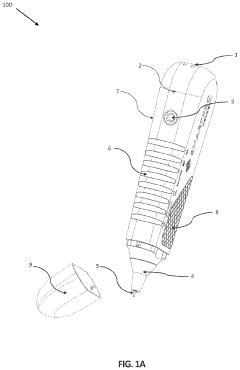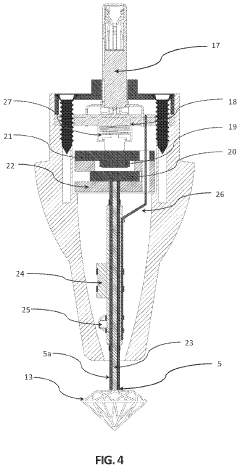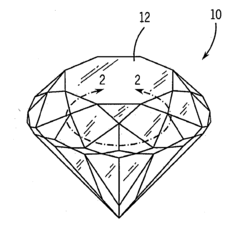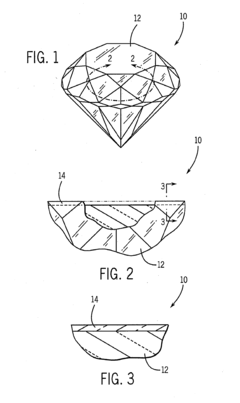What is Cubic Zirconia?
Cubic Zirconia Overview
Cubic zirconia, often abbreviated as CZ, is a synthetic gemstone that has gained significant popularity in the jewelry industry as a diamond simulant. This crystalline form of zirconium dioxide (ZrO2) was first discovered in 1937 but only became commercially viable for gem production in the 1970s. Its remarkable visual similarity to diamond, coupled with its affordability, has made it a widely used alternative in jewelry making.
The creation of cubic zirconia involves a high-temperature fusion process known as skull melting. This technique allows for the production of a material with a cubic crystal structure, which is essential for achieving its diamond-like optical properties. The resulting gemstone exhibits exceptional brilliance, fire, and clarity, often surpassing natural diamonds in these aspects.
One of the key characteristics of cubic zirconia is its high refractive index, which contributes to its intense sparkle. With a refractive index of 2.15-2.18, it closely mimics that of diamond (2.42), making it difficult for the untrained eye to distinguish between the two. Additionally, cubic zirconia has a dispersion rate of 0.060, higher than diamond's 0.044, resulting in more pronounced fire and rainbow-like flashes of color.
In terms of hardness, cubic zirconia ranks 8.5 on the Mohs scale, making it more durable than many other gemstones but less resistant to scratching compared to diamond, which tops the scale at 10. This relative softness can lead to some wear over time, particularly in frequently worn jewelry pieces.
Cubic zirconia can be produced in a variety of colors by incorporating different metal oxides during the manufacturing process. This versatility allows for the creation of gemstones that simulate not only colorless diamonds but also fancy colored diamonds and other precious stones.
The affordability of cubic zirconia has made it accessible to a wide range of consumers, enabling the creation of larger, more elaborate jewelry designs that would be prohibitively expensive with natural diamonds. This has democratized the wearing of diamond-like jewelry and expanded design possibilities for jewelers.
While cubic zirconia is primarily known as a diamond simulant, it has found applications beyond jewelry. Its optical properties make it useful in certain scientific and industrial applications, such as in laser technology and precision optics. Additionally, its thermal properties and chemical stability have led to its use in some specialized ceramic materials.
Market Demand Analysis
The market demand for cubic zirconia has shown significant growth in recent years, driven by several key factors. As a synthetic gemstone that closely resembles diamond, cubic zirconia has gained popularity as an affordable alternative in the jewelry industry. Its optical properties, including high refractive index and dispersion, make it an attractive option for consumers seeking the appearance of diamond without the associated cost.
The global cubic zirconia market has experienced steady expansion, with a notable increase in demand from emerging economies. This growth can be attributed to rising disposable incomes, changing consumer preferences, and a growing awareness of synthetic gemstones. The fashion jewelry segment, in particular, has embraced cubic zirconia as a versatile material for creating trendy and accessible pieces.
One of the primary drivers of market demand is the increasing acceptance of cubic zirconia in engagement rings and wedding bands. As couples seek more cost-effective options for their nuptial jewelry, cubic zirconia has emerged as a popular choice. This trend is especially pronounced among younger generations who prioritize value and ethical considerations in their purchasing decisions.
The industrial applications of cubic zirconia have also contributed to its market growth. Its high melting point, hardness, and chemical stability make it suitable for use in various industries, including electronics, optics, and ceramics. The demand for cubic zirconia in these sectors is expected to continue expanding as technological advancements create new applications.
Environmental and ethical concerns surrounding natural diamond mining have further bolstered the appeal of cubic zirconia. Consumers increasingly seek sustainable and conflict-free alternatives, positioning cubic zirconia as an environmentally friendly option in the gemstone market. This shift in consumer sentiment has led to a reevaluation of traditional gemstone preferences and opened new opportunities for synthetic alternatives.
The e-commerce boom has played a crucial role in expanding the market reach of cubic zirconia products. Online platforms have made it easier for consumers to compare prices, styles, and quality, driving competition and innovation among manufacturers and retailers. This digital transformation has also facilitated the growth of direct-to-consumer brands specializing in cubic zirconia jewelry, further democratizing access to affordable luxury.
Despite the positive market outlook, challenges remain. The perception of cubic zirconia as a "fake" diamond persists among some consumers, necessitating ongoing education and marketing efforts to highlight its unique properties and value proposition. Additionally, competition from other synthetic gemstones and evolving consumer preferences present potential hurdles for sustained market growth.
Technical Challenges
Despite its widespread use and popularity in the jewelry industry, cubic zirconia faces several technical challenges that limit its performance and application. One of the primary issues is its relatively low hardness compared to natural diamonds. While cubic zirconia measures 8.5 on the Mohs scale, diamonds score a perfect 10. This difference in hardness makes cubic zirconia more susceptible to scratches and wear over time, potentially diminishing its aesthetic appeal and longevity.
Another significant challenge lies in the production process of cubic zirconia. The synthesis of high-quality cubic zirconia crystals requires precise control of temperature, pressure, and atmospheric conditions. Achieving consistent quality and size in large-scale production can be difficult, leading to variations in the final product's appearance and properties. This inconsistency can affect the overall market perception and value of cubic zirconia as a diamond simulant.
The optical properties of cubic zirconia, while similar to diamonds, still present some technical hurdles. Its higher refractive index (2.15-2.18) compared to diamond (2.42) results in a different light dispersion pattern. This difference can be noticeable to trained eyes or under certain lighting conditions, making it challenging to create a perfect diamond imitation. Additionally, cubic zirconia's higher specific gravity (5.6-6.0) compared to diamond (3.52) means that a cubic zirconia stone of the same size will be noticeably heavier than a diamond, potentially affecting jewelry design and wearability.
Thermal conductivity is another area where cubic zirconia falls short of natural diamonds. The significantly lower thermal conductivity of cubic zirconia can lead to heat retention, which may cause discomfort when worn in certain settings or climates. This property also makes it easier to distinguish cubic zirconia from diamonds using thermal testing methods, limiting its use in high-end jewelry applications where authenticity is crucial.
Color stability presents an ongoing challenge for cubic zirconia manufacturers. While it can be produced in various colors, maintaining color consistency and stability over time can be problematic. Some cubic zirconia stones may experience color changes or fading when exposed to UV light or certain chemicals, affecting their long-term appearance and value.
Lastly, the environmental impact of cubic zirconia production is an emerging concern. The energy-intensive manufacturing process and the use of certain stabilizing agents raise questions about sustainability and eco-friendliness. As consumers become more environmentally conscious, addressing these concerns through improved production methods and materials becomes a critical technical challenge for the industry.
Current Manufacturing
01 Synthesis and production methods of cubic zirconia
Various techniques for synthesizing and producing cubic zirconia are explored, including different growth methods, temperature control, and stabilization processes. These methods aim to improve the quality, size, and properties of the resulting crystals for use in jewelry and other applications.- Synthesis and production methods of cubic zirconia: Various techniques for synthesizing and producing cubic zirconia, including crystal growth methods, stabilization processes, and manufacturing techniques to create high-quality synthetic gemstones with specific properties.
- Optical and physical properties enhancement: Methods to improve the optical and physical properties of cubic zirconia, such as increasing brilliance, hardness, and durability. This includes techniques for color modification, refractive index adjustment, and surface treatment to enhance overall quality.
- Applications in jewelry and decorative items: Use of cubic zirconia in various jewelry and decorative applications, including methods for setting, mounting, and incorporating the synthetic gemstone into different designs and products to create attractive and affordable alternatives to natural diamonds.
- Industrial and technological applications: Utilization of cubic zirconia in industrial and technological applications beyond jewelry, such as in optical components, sensors, electronic devices, and advanced materials due to its unique properties and stability at high temperatures.
- Quality control and authentication methods: Techniques for quality control, authentication, and differentiation of cubic zirconia from natural diamonds and other synthetic gemstones. This includes advanced testing methods, identification processes, and grading systems to ensure product integrity and consumer confidence.
02 Coloring and doping of cubic zirconia
Techniques for introducing color and modifying the optical properties of cubic zirconia through doping with various elements or compounds. This includes methods for achieving specific hues, enhancing brilliance, and creating unique visual effects in the synthetic gemstones.Expand Specific Solutions03 Applications in jewelry and decorative items
Use of cubic zirconia in jewelry making and decorative objects, including setting techniques, integration with other materials, and design considerations to maximize the aesthetic appeal of the synthetic gemstone in various ornamental applications.Expand Specific Solutions04 Industrial and technical applications of cubic zirconia
Exploration of cubic zirconia's use beyond jewelry, including applications in optics, electronics, and other industrial fields. This covers its use as a diamond simulant in scientific instruments, as a component in specialized ceramics, and in high-temperature or high-pressure environments.Expand Specific Solutions05 Quality assessment and characterization techniques
Methods and technologies for evaluating the quality, authenticity, and properties of cubic zirconia. This includes spectroscopic analysis, hardness testing, and other characterization techniques to distinguish cubic zirconia from natural diamonds and assess its quality for various applications.Expand Specific Solutions
Key Industry Players
The cubic zirconia market is in a mature stage, with a global market size estimated in the hundreds of millions of dollars. This synthetic gemstone, known for its diamond-like appearance, has widespread applications in jewelry and industrial sectors. Technologically, cubic zirconia production is well-established, with companies like Saint-Gobain Centre de Recherches et d'Études Européen SAS and Corning, Inc. leading in advanced materials research. The competitive landscape includes diverse players from materials science, such as Tosoh Corp. and Kuraray Noritake Dental, Inc., focusing on improving synthesis techniques and exploring new applications. While the market is stable, ongoing research by entities like Jilin University and New York University suggests potential for innovation in optical and electronic properties, potentially opening new market segments.
Corning, Inc.
Apple, Inc.
Core Innovations
- A handheld gemstone tester with a probe that includes a copper tube with optical fibers, a thermal testing assembly, and an optical testing assembly using UV light, coupled with a microcontroller to determine the gemstone's thermal, electrical, and optical properties, allowing for accurate identification.
- A diamond simulant composed of yttrium and zirconia with a sapphire or Al2O3 coating applied to enhance hardness and optical properties, mimicking those of diamonds, and potentially including hafnium and gadolinium for improved characteristics.
Material Properties
Cubic Zirconia (CZ) is a synthetic gemstone with remarkable material properties that make it a popular diamond simulant. Its chemical composition is ZrO2, crystallizing in a cubic crystal system. The material exhibits exceptional hardness, measuring 8.5 on the Mohs scale, which is significantly harder than most natural gemstones except diamond. This high hardness contributes to its durability and resistance to scratching, making it suitable for use in jewelry and other decorative applications.
One of the most notable properties of Cubic Zirconia is its high refractive index, ranging from 2.15 to 2.18, which is close to that of diamond (2.42). This characteristic allows CZ to display brilliant light dispersion and fire, closely mimicking the optical properties of diamond. The material also possesses a high specific gravity of 5.6 to 6.0, which is denser than most natural gemstones but less dense than diamond.
Cubic Zirconia is optically isotropic, meaning it has a single refractive index and does not exhibit birefringence. This property contributes to its ability to closely simulate the appearance of diamond. The material is also highly transparent, with minimal inclusions or imperfections, allowing for excellent light transmission and clarity.
In terms of thermal properties, Cubic Zirconia has a relatively low thermal conductivity compared to diamond. This characteristic can be used to distinguish CZ from natural diamond, as thermal probes will detect a significant difference in heat dissipation between the two materials. The melting point of Cubic Zirconia is approximately 2750°C, which is considerably higher than most other gemstone materials.
Cubic Zirconia exhibits excellent chemical stability and resistance to corrosion. It is inert to most acids and bases at room temperature, making it suitable for use in various environments without degradation. The material also demonstrates good resistance to thermal shock, maintaining its structural integrity under rapid temperature changes.
One unique property of Cubic Zirconia is its ability to be produced in a wide range of colors by incorporating various dopants during the synthesis process. This versatility allows manufacturers to create CZ gemstones that simulate a variety of colored diamonds and other precious stones, expanding its applications in the jewelry industry.
Ethical Considerations
The ethical considerations surrounding cubic zirconia primarily revolve around its use as a diamond simulant and its impact on the diamond industry. While cubic zirconia offers a more affordable alternative to natural diamonds, its production and marketing raise several ethical concerns.
One of the main ethical issues is the potential for deception in the jewelry market. As cubic zirconia closely resembles diamonds in appearance, there is a risk of unscrupulous sellers misrepresenting it as natural diamonds to unsuspecting consumers. This practice not only violates consumer trust but also undermines the integrity of the jewelry industry as a whole. To address this concern, strict labeling and disclosure requirements have been implemented in many countries to ensure that cubic zirconia is clearly identified as a synthetic gemstone.
The environmental impact of cubic zirconia production is another ethical consideration. While its manufacture is generally less environmentally damaging than diamond mining, the process still requires significant energy consumption and may involve the use of potentially harmful chemicals. As consumers become more environmentally conscious, there is a growing demand for transparency in the production methods and environmental footprint of synthetic gemstones like cubic zirconia.
The socioeconomic implications of cubic zirconia on diamond-producing regions also warrant ethical scrutiny. The availability of affordable diamond simulants could potentially reduce demand for natural diamonds, impacting the livelihoods of communities dependent on diamond mining. This raises questions about the responsibility of the synthetic gemstone industry in supporting sustainable development in these regions.
Intellectual property rights and fair competition are additional ethical concerns in the cubic zirconia market. As research and development in synthetic gemstone production continue, there is a need to balance innovation with respect for existing patents and trade secrets. Ensuring fair competition and preventing industrial espionage are crucial for maintaining ethical standards in the industry.
The use of cubic zirconia in medical and industrial applications also presents ethical considerations. In medical implants, for instance, the safety and long-term effects of cubic zirconia must be thoroughly evaluated to ensure patient well-being. Similarly, in industrial uses, the potential environmental and health impacts of cubic zirconia components need to be carefully assessed and mitigated.
As the popularity of cubic zirconia grows, there is an increasing need for ethical guidelines and industry standards. These should address issues such as responsible sourcing of raw materials, fair labor practices in production facilities, and transparent marketing practices. By proactively addressing these ethical considerations, the cubic zirconia industry can foster trust, sustainability, and responsible innovation in the broader gemstone and jewelry market.





